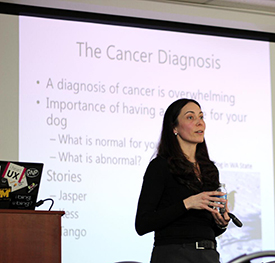Alum Chronicles the Canine Dying Process
-
-
slice.mit.edu
Filed Under
Recommended

When Lola Ball ’91, SM ’92 was growing up in Brooklyn, the tight city living never allowed for a dog. But after graduating from MIT and moving to Colorado, she got a Chocolate Lab, Porter, and immediately fell in love. A second Lab, Scooby, followed shortly after.
But when Porter was diagnosed with cancer in early 2008, Ball felt overwhelmed, unprepared, and unsure of the best course of action. “It wasn’t something I ever expected,” she says. “There isn’t a single pet owner I’ve met that was ready for it.”
The cancer was located near many of Porter’s organs and surgery and chemotherapy were not an option. Ball settled on one goal: Make Porter as comfortable as possible.
“It’s hard to know the right thing to do,” she says. “I was open to anything—acupuncture, animal massage, and holistic therapy. The only thing was to give him the best quality of life. I was essentially doing hospice care.”
Porter died a few months after his diagnosis. Ball was overwhelmed by the experience.
“I didn’t want anyone to go through the trial-and-error I went through,” she says. “I became very passionate about sharing my message.”
 Her book, When Your Dog Has Cancer—Making the Right Decisions for You and Your Dog, was published earlier this year. Ball says the book includes an end-of-life plan and hospice tool kit that can help any canine owner through the dying experience.
Her book, When Your Dog Has Cancer—Making the Right Decisions for You and Your Dog, was published earlier this year. Ball says the book includes an end-of-life plan and hospice tool kit that can help any canine owner through the dying experience.
“It’s hard to make sense of what’s best for you and your family,” she says. “No two dogs will ever have the exact same situation. It’s a vast continuum that ranges from standard cancer treatments like chemotherapy to hospice, natural dying, and euthanizing options.
Ball, now living in Washington, wrote the book while working full-time as a program manager at Microsoft. While canine cancer may seem worlds apart from the rigidity of programming, Ball says she applied an engineering mentality to writing the book and chronicling Porter’s experience.
“In engineering, it’s about knowing your facts,” she says. “You take a logical approach. What are the conditions and requirements? Similar to caring for a dog, you dissect what you’re faced with and the pros and cons will dictate your decision.”
In 2009, Ball adopted Jasper, a Labrador Retriever-Hound mix, from Pasado’s Safe Haven, an animal sanctuary near Seattle. About a year later, Jasper was diagnosed with cancer and Ball relied on her experiences with Porter to navigate Jasper’s final months.
“The second experience was much smoother,” she says. “I knew more about the dying process. Being prepared helps make the experience a little less awful.”
Today, Ball’s home includes Scooby, now 13, and Apollo, 3, a Springer Spaniel-Rottweiler mix who was born on the day that Jasper died. She is a founding member and board member on AHELP (Animal Hospice End of Life Project).
“At the end of your pet’s life, it’s about giving them more good days than bad days,” she says. “As pet owners, we can take responsibility to make their treatment the best possible.”
Read more about When Your Dog Has Cancer—Making the Right Decisions for You and Your Dog.







